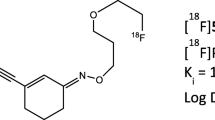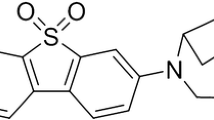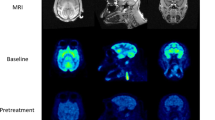Abstract
Purpose
Sigma-1 receptors (S1Rs) play an important role in many neurological disorders. Simultaneous positron emission tomography (PET)/magnetic resonance imaging (MRI) with S1R radioligands may provide valuable information for diagnosing and guiding treatment for these diseases. Our previously reported S1R radioligand, [18F]FTC-146, demonstrated high affinity for the S1R (K i = 0.0025 nM) and excellent selectivity for the S1R over the sigma-2 receptor (S2Rs; K i = 364 nM) across several species (from mouse to non-human primate). Herein, we report the clinical-grade radiochemistry filed with exploratory Investigational New Drug (eIND) and first-in-human PET/MRI evaluation of [18F]FTC-146.
Procedures
[18F]FTC-146 is prepared via a direct [18F] fluoride nucleophilic radiolabeling reaction and formulated in 0.9 % NaCl containing no more than 10 % ethanol through sterile filtration. Quality control (QC) was performed based on USP 823 before doses were released for clinical use. The safety and whole body biodistribution of [18F]FTC-146 were evaluated using a simultaneous PET/MR scanner in two representative healthy human subjects.
Results
[18F]FTC-146 was synthesized with a radiochemical yield of 3.3 ± 0.7 % and specific radioactivity of 8.3 ± 3.3 Ci/μmol (n = 10, decay corrected to EOB). Both radiochemical and chemical purities were >95 %; the prepared doses were stable for 4 h at ambient temperature. All QC test results met specified clinical criteria. The in vivo PET/MRI investigations showed that [18F]FTC-146 rapidly crossed the blood brain barrier and accumulated in S1R-rich regions of the brain. There were also radioactivity distributed in the peripheral organs, i.e., the lungs, spleen, pancreas, and thyroid. Furthermore, insignificant uptake of [18F]FTC-146 was observed in cortical bone and muscle.
Conclusion
A reliable and automated radiosynthesis for providing routine clinical-grade [18F]FTC-146 for human studies was established in a modified GE TRACERlab FXFN. PET/MRI demonstrated the initial tracer biodistribution in humans, and clinical studies investigating different S1R-related diseases are in progress.



Similar content being viewed by others
References
Hanner M, Moebius FF, Flandorfer A et al (1996) Purification molecular cloning, and expression of the mammalian sigma(1)-binding site. Proc Natl Acad Sci U S A 93:8072–8077
Hayashi T, Su TP (2004) Sigma-1 receptor ligands—potential in the treatment of neuropsychiatric disorders. CNS Drugs 18:269–284
Fishback JA, Robson MJ, Xu YT, Matsumoto RR (2010) Sigma receptors: potential targets for a new class of antidepressant drug. Pharmacol Therapeut 127:271–282
Narita N, Hashimoto K, Tomitaka S, Minabe Y (1996) Interactions of selective serotonin reuptake inhibitors with subtypes of sigma receptors in rat brain. Eur J Pharmacol 307:117–119
Robson MJ, Noorbakhsh B, Seminerio MJ, Matsumoto RR (2012) Sigma-1 receptors: potential targets for the treatment of substance abuse. Curr Pharm Design 18:902–919
Matsumoto RR, McCracken KA, Pouw B et al (2002) Involvement of sigma receptors in the behavioral effects of cocaine: evidence from novel ligands and antisense oligodeoxynucleotides. Neuropharmacology 42:1043–1055
Liu Y, Matsumoto RR (2008) Alterations in fos-related antigen 2 and sigma(1) receptor gene and protein expression are associated with the development of cocaine-induced behavioral sensitization: time course and regional distribution studies. Eur J Pharmacol 327:187–195
Nieto FR, Cendan CM, Sanchez-Fernandez C et al (2012) Role of sigma-1 receptors in paclitaxel-induced neuropathic pain in mice. J Pain 13:1107–1121
Kawamura K, Ishiwata K, Tajima H et al (2000) In vivo evaluation of [C-11]SA4503 as a PET ligand for mapping CNS sigma(1) receptors. Nucl Med Biol 27:255–261
Collier TL, O’Brien JC, Waterhouse RN (1996) Synthesis of [18F]-l-(3-FIuoropropyI)-4-(4-cyanophenoxymethyl)-piperidine: a potential sigma-1 receptor radioligand for PET. J Label Compd Radiopharm 38:785–794
Lever JR, Gustafson JL, Xu R et al (2006) Sigma(1) and sigma(2) receptor binding affinity and selectivity of SA4503 and fluoroethyl SA4503. Synapse 59:350–358
Waterhouse RN, Nobler MS, Zhou Y et al (2004) First evaluation of the sigma-1 receptor radioligand [18F]1-3-fluoropropyl-4-((4-cyanophenoxy)-methyl)piperidine ([18F]FPS) in humans. NeuroImage 22(Supp 2):T29–T30
Fischer S, Wiese C, Maestrup EG et al (2011) Molecular imaging of sigma receptors: synthesis and evaluation of the potent sigma(1) selective radioligand [F-18]fluspidine. Eur J Nucl Med Mol Imaging 38:540–551
Bhuiyan MDS, Fukunaga K (2011) Targeting sigma-1 receptor signaling by endogenous ligands for cardioprotection. Expert Opin Ther Tar 15:145–155
Ishiwata K, Kawamura K, Yajima K et al (2006) Evaluation of (+)-p-[C-11]methylvesamicol for mapping sigma(1) receptors: a comparison with [C-11]SA4503. Nucl Med Biol 33:543–548
Kranz M, Sattler B, Wüst N et al (2016) Evaluation of the enantiomer specific biokinetics and radiation doses of [18F]fluspidine—a new tracer in clinical translation for imaging of σ1 receptors. Molecules 21:1164
James ML, Shen B, Zavaleta CL et al (2012) New positron emission tomography (PET) radioligand for imaging sigma-1 receptors in living subjects. J Med Chem 55:8272–8282
James ML, Shen B, Nielsen CH et al (2014) Evaluation of sigma-1 receptor radioligand F-18 FTC-146 in rats and squirrel monkeys using PET. J Nucl Med 55:147–153
Shen B, James ML, Andrews L et al (2015) Further validation to support clinical translation of [F-18]FTC-146 for imaging sigma-1 receptors. Eur J Nucl Med Mol Iimaging Res DOI. doi:10.1186/s13550-015-0122-2
United States Pharmacopeia Chapter 823 (2009). USP 32 - NF 27, “Radiopharmaceuticals for positron emission tomography compounding.” volume 1: 365–369
Acknowledgements
We would like to thank Dr. Erik S. Mittra for servicing as nuclear medicine doctor and Mr. Harsh Gandhi for providing technical support in human study and the MIPS Cyclotron & Radiochemistry Facility and also PET/MRI Metabolic Service Center for their support. This research was financially supported in part by the NCI ICMIC P50 CA114747 (SSG), NIDA R01 DA023205 (CRM), NIGMS P20 GM104932 (CRM), The Ben & Catherine Ivy Foundation (FTC), and General Electric Healthcare Research Support (SB and FTC).
Author information
Authors and Affiliations
Corresponding authors
Ethics declarations
Two healthy human subjects (male, age 31 years; female, age 36 years) were recruited, and written informed consent was obtained via a protocol approved by the Stanford University Institutional Review Board (IRB).
Conflict of Interest
The authors declare that they have no conflicts of interest.
Rights and permissions
About this article
Cite this article
Shen, B., Park, J.H., Hjørnevik, T. et al. Radiosynthesis and First-In-Human PET/MRI Evaluation with Clinical-Grade [18F]FTC-146. Mol Imaging Biol 19, 779–786 (2017). https://doi.org/10.1007/s11307-017-1064-z
Published:
Issue Date:
DOI: https://doi.org/10.1007/s11307-017-1064-z




